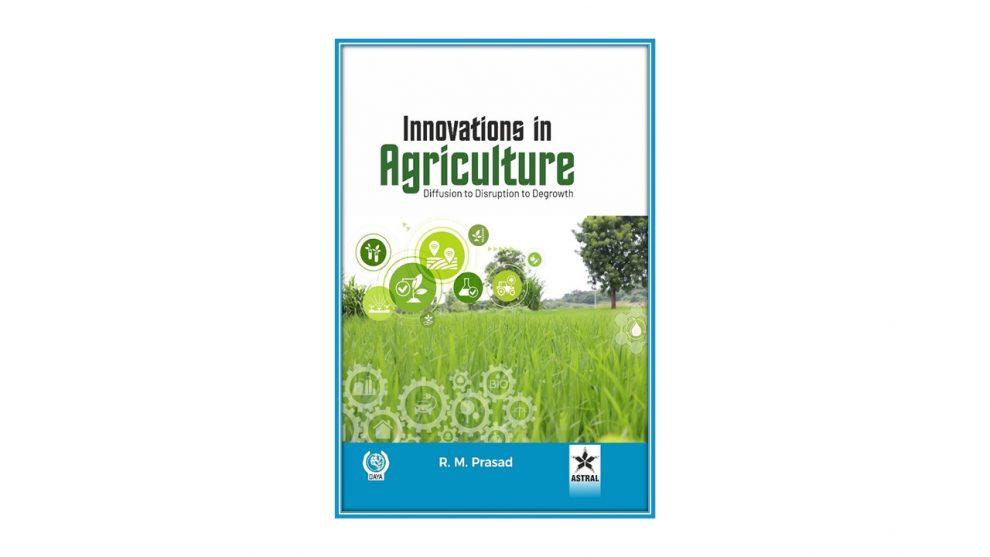RM Prasad (2023)
Astral International Pvt Ltd
334 pages
INR 1,723
ISBN-13: 978-935461675
Innovation is essential for the development of society as it has the potential to address the challenges of reducing hunger, providing access to potable water, eradicating diseases, promoting climate smart agriculture, etc. However, many scholars and practitioners use the term ‘innovation’ very loosely without understanding the meaning of the term and its different aspects. Extension professionals talk of innovation even today, mostly based on the ‘Diffusion of Innovations’ paradigm, even though the field of innovation studies has expanded over the past three decades. Dr R M Prasad in this book “Innovations in Agriculture: Diffusion to Disruption to Degrowth” has tried to help readers understand how the term innovation has evolved over the years and what are its implications for agricultural development.
In the first chapter, Dr Prasad introduces the concept of Innovation through several definitions, explaining the different types of innovations, the varied fields of innovation, and innovation in the context of agricultural development. The second chapter is devoted to the dynamics of the innovation process. The basis for designing an innovation process is explained through a seven-step model, namely, i) Strategic direction; ii) Inspiration; iii) Ideation; iv) Proof of concept; v) Prototype testing; vi) Roll out and production; and viii) Feedback and launch. The concept of social innovation was described with reference to social mechanisms and social responsibility of innovations, and risks of innovation.
The innovation ecosystem is explained in Chapter 3. It deals with actors, activities, institutions, and how their relations evolved while developing new products and services. The evolution of the present Science Technology and Innovation Policy (STIP 2020) from the main Science Policy of India (Scientific Policy Resolution – SPR 1958) was elucidated so as to provide a brief history and development of the innovation ecosystem in India. It also contains the innovation ecosystem initiatives of the major departments, which include Department of Science & Technology (DST), Department of Scientific and Industrial Research (DSIR), Innovation Management Directorate of CSIR, and Department of Biotechnology (DBT). The other initiatives are Intellectual Property and Technology Management Unit, and the National Agricultural Innovation Fund (NAIF) under the Indian Council of Agricultural Research (ICAR) in addition to Agrinnovate India under the Ministry of Agriculture and Farmers’ Welfare.
There are brief descriptions of the innovations of rural India (Accelerating Growth of New India’s Innovations (AGNIi), Atal Innovation Mission (AIM), and development of the India Innovation Index that ranks the States and UTs on the innovation index score. International organizations promoting innovations in agriculture are also listed. The book also covers the main challenges of the Indian innovation system such as fragmented policy and policy implementation, inadequate funding for R&D, cumbersome procedures for funding, weak linkages between stakeholders, etc.
Diffusion of Technological Innovations in Agriculture is presented in Chapter 4. Several theories on Diffusion of Innovations, including some models from Marketing, Sociology, Economics in addition to the most popular theory of Rogers are very well presented. It also describes major criticism of diffusion theory and several studies that challenge it, thereby indicating the need to work on developing a comprehensive theory to explain the process of diffusion of innovations. Fortunately, the new curricula at the Master’s level in agricultural extension, developed by the Indian Council of Agricultural Research (ICAR), has tried to provide a broader and more up-to-date understanding of innovation and the role of extension and advisory services in enabling innovation. Therefore, students of extension will find this chapter especially relevant.
Disruptive innovations are those which create new markets and challenge the established markets by substituting or complementing existing products, processes or business models. They make the products and services accessible to a larger population. Five groups of disruptive technologies in agriculture were described with good examples. These groups include: i) Digital agricultural technology (ICT, Big data, Robotics); ii) Biotechnology and nano technology (Genome edited crops); iii) Controlled environment food farming fusing ICT and biology (Plant factory with artificial light); iv) Food/Feed/Fibre technologies (Blockchain to prevent product fraud); and v) Supply chain connectivity (Digital platforms). Similarly, some of the important transformative Disruptive Technology Innovations in agriculture (GIS and GPS, Big Data, Imagery from Satellites, Internet of Things, Cloud Computing, Drones, Robotics and Artificial Intelligence – AI) were also described briefly. The potential of AI in agriculture vis-à-vis its challenges in application with suitable examples were elucidated. Finally, barriers while scaling up digital innovations are also presented.
Chapter 6 is all about Innovation and Entrepreneurship in Agriculture. It highlights the need for innovation skills; leaders must acquire the ability to face the challenges arising from volatility, uncertainty, complexity and ambiguity in the world. Together with examples, it describes how the policy of developing customer centric products evolved, preparing the entrepreneurs to focus on understanding the market and customer preferences. It also introduces the theory of ‘effectuation’, which explains the process that entrepreneurs use to create new ventures.
The technology ecosystem model was explained through the story of cassava peels in Nigeria. These peels, a source of environmental pollution there, was converted into an ingredient in high quality fish feed as a substitute to maize. The Social Venture Impact Metric was developed by the Natural Resources Institute, UK, to assess the impact resulting from business innovations. Although business innovations have several impacts, the author stressed the need for designing the innovations to address the problems faced by low-income populations (Base of Pyramid Population). There was excellent coverage on developing entrepreneurship in agriculture, which includes agri clinics and agribusiness centres, agribusiness incubators, agri startups and government initiatives and policies to promote these startups.
Chapter 7 explains the concept of Degrowth and its goals. The main goal is to reduce the environmental impact of human society and promote the transition from a materialistic to a convivial and participatory society. The degrowth movement across the globe arose from major concern over the perceived consequences of industrial development, such as i) reduced availability of energy resources; ii) declining quality of the environment; iii) rise of unsustainable development; and iv) exploitative use of resources to satisfy lavish lifestyles resulting in dumping of greater waste. The roots of the degrowth movement can be traced back to Simone Weil’s concept of ‘rootedness’ (1909-1943). Now Degrowth is conceived as a movement wherein people consume products that use less resources, have better longevity, and produce less waste.
The author presents an interesting case study on the Kerala Sasthra Sahitya Parishath (KSSP), a progressive NGO, as an example to counter hegemonic practices in a non-western setting. Similarly, based on the analysis of three cases the author concluded that institutional innovations, such as urban community supported farming model (Dream Grove – a gardening initiative in Mumbai), participatory guarantee system of certification in Anantapur district of AP, and sale of carbide free Kesar mangoes in Ahmedabad by Gujpro, an FPO that enables sustainable transitions in agriculture, are essential. The book also quotes several initiatives taken up by the ICAR and Government of India under the Climate Change and Degrowth strategy.
There is a separate chapter on innovation management and innovation intermediaries in agriculture. Indicators of successful innovation, such as context, leadership, planning, support, operations, evaluation and improvement, are highlighted. Conceptual issues and functions of innovation intermediaries are discussed at length. Given the several agents in agriculture the author thinks that FPOs have the potential to address farmers’ challenges, which include improved access to investments, technology, farm inputs, and markets.
Innovations in service delivery in agriculture are presented in Chapter 9. The World Development Report (2004) on ‘Making Services Work for the Poor’ called for greater accountability if the quality of services, especially to the poor who lack access to basic services, is to be improved. The five basic principles identified for effective delivery are: Relentless focus on citizen outcomes, multidimensional response, evidence to achieve results, leadership for change, and adaptive implementation. The Global Delivery Initiative launched by the World Bank in 2015 supports the science of delivery by building on the experience of its partners. This chapter also describes models of extension service delivery, innovation platforms, and institutional innovations in agriculture, service delivery framework, and national innovation system for development.
In conclusion, the author suggested several changes required in agricultural research and technology for better service delivery. These changes include: i) Positioning smallholder farmers at centre stage; ii) Nutrition security as the main goal; iii) Greater role for research, science, technology and innovation; and iv) Focus on climate smart agriculture, evergreen economy, and commercial agriculture, etc.
Several terminologies are in vogue: pro-poor innovation, grassroots innovation, below the radar innovation, participatory innovation, inclusive innovation and responsible innovation. The dimensions that determine whether an innovation process is inclusive are i) who participates in the innovation; ii) what kind of activities the process involves; iii) the outcomes and beneficiaries of these outcomes; and iv) how and by whom is the innovation system governed. Responsible Innovation (as the term indicates) is the process that must meet certain norms such as accountability, inclusiveness and transparency, pertaining both to stakeholders as well as to the society at large. Responsible Research and Innovation is an emerging field in Europe, which aims at balancing economic, socio cultural and environmental aspects in innovation processes.
This book certainly helps readers to understand several dimensions of the concept of innovation, such as pro-poor innovation, grassroots innovation, below the radar innovation, participatory innovation, inclusive innovation, and responsible innovation. Undoubtedly, it serves as a very useful reference book for all those who are working on innovations, especially those who wish to develop responsible innovations in agriculture and allied sciences for greater social improvement.
S V N Rao

Dr SVN Rao, Professor and Head (Retd.), Department of Veterinary and Animal Husbandry Extension Education, Rajiv Gandhi Institute of Veterinary Education and Research (RIVER), Puducherry. He can be contacted at: svnrao1953@gmail.com / Mob: 9443007506.





Add Comment